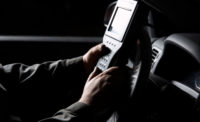Anyone active on Facebook and Twitter in 2015 likely remembers the argument over the color of a blue and black dress. Or was it white and gold? A person’s allegiance fell into one of two camps depending on how their brain perceived the colors, relative to the dress’s background lighting. The viral bout of optical difference even inspired white papers studying the scientific basis behind the dispute, before fading away from the internet’s short attention span.
Fortunately, quality control experts don’t need to rely on the subjectivity of the human eye, and have an array of spectrophotometers, colorimeters and associated software tools to objectively control for color. Whether a manufacturer produces plastics, paints, coatings, textiles, consumer electronics, cosmetics or automobiles, color measurement and management is a must in any color-critical environment.
Still, despite the plethora of scientific methods for evaluating color, it is not uncommon to find misconceived faith placed in human visual color inspection.
“We still hear about people taking samples to the parking lot at noon to evaluate color, and this is a process that is rife with error,” says Felix Schmollgruber, application engineering manager EMEA, X-Rite.
To learn more about the challenges and trends in color measurement, Quality spoke more with Schmollgruber, along with Ken Butts, global team account manager for Datacolor, and Jeff Watts, market manager for paint and coatings, Datacolor.
Quality: What are the basic concepts behind spectro-
photometers and colorimeters?
Ken Butts: There are three aspects to color. When light strikes an object, some of the light is absorbed, some is reflected, and the observer receives that in response to it.
The spectrophotometer acts like an observer, in the sense that it records how light interacts with an object. And it reports reflectants—how much light that strikes the object is reflected at each wavelength, typically between 400-700 nanometers. That produces what’s called a reflectants curve.
When we calculate the colorimetric values, we have to look at the reflectants data, plus the energy of the light source itself, and plus another value that describes how we see color as humans. That’s called the standard observer. Those three aspects—the reflectants curve, the spectral power distribution of the light source, and the standard observer response function—go together to define the color numbers.
If you change the light source, or if you change the observer, then the numbers change with a colorimeter.
A spectrophotometer produces just the reflectants data. A colorimeter is only going to produce data for a specific light source and observer, and it does that with a set of filters. So when light strikes an object, rather than recording reflectants it actually records how much light passes a set of red, green and blue filters. And those filters have been tuned to a specific light source, like daylight. So rather than having to have a complex system of light separation and diodes that record energy between 400-700 nanometers, a colorimeter simply has a set of red, green and blue filters. When the light passes through those filters you just get three numbers, rather than getting potentially 31 numbers. A spectrophotometer is independent, it only records reflects from a surface of a sample.
A spectrophotometer gives us reflectants data for a sample that then facilitates calculation of color change from one light source to another. So in that sense, it’s much more flexible. But, of course, a spectrophotometer is much more expensive. So they have different applications. If you are in the business of developing new colors, you want to identify the right color. Does it match a standard? Well, then it’s important that you know how this recipe will look under multiple light sources, so you have to use a spectrophotometer.
If, on the other hand, if you’re just looking for a quality control application, where you want to know “does the sample I produce today match the sample I produced yesterday?” Well, in that case they have the same colorants, so I don’t have to worry about color change from one light source to another. In that case, a colorimeter should work just fine, because I’m not worried about looking at the sample in different light sources.
How has color measurement changed in the recent past?
Felix Schmollgruber: Over the last five to 10 years, we have seen trends toward expanded color palettes and special effects pigments. The emergence of new resins, manufacturing technologies, pigments and changes in the regulatory environment for plastic materials have led to a greater need for precise color measurement technology. In addition, color tolerances are tighter today than they were 10 years ago. With a smaller margin for error, suppliers need to get color right the first time and every time.
For example, special effect pigments, such as metallic flakes, pearlescents and multi-chromatic pigments, affect the way color appears and must be measured and managed differently than traditional colorants. This requires the use of next-generation spectrophotometers designed to help measure special effect pigments.
The increased use of optical brighteners—chemicals used to make “white appear whiter and brighter”—in plastics has also impacted color management processes. If optical brighteners are used, manufacturers need measurement tools that account for UV.
Equally important, many different manufacturers have become more and more distributed while dealing with increasing restrictions, environmental regulations, and other requirements. Many products are specified globally but produced and/or sold locally and are subject to local/regional regulations. This means that manufacturing processes and materials may differ, making it harder to get to accurate and consistent color.
Are you seeing trends as far as benchtop machine use vs. handheld instruments vs. automated inline solutions?
Schmollgruber: This will vary from operation to operation. The lab still has an important role to play, as do inline automated measurement solutions in the production environment. The lab will primarily be doing formulation work, and perhaps some quality control. Benchtops are the instrument of choice.
In the case of inline measurement solutions, corrections can often be made automatically, reducing waste and conserving expensive colorants while making operators more efficient and reducing line downtime. Handhelds are convenient for spot measurements throughout the entire supply chain, including on the production floor, minimizing the need to carry samples to the lab for measurement.
Many specifiers—brand owners, designers, etc.—will also use benchtops to both develop specifications and check color accuracy on final product. All instruments should be regularly calibrated and serviced.
What trends are you seeing in illumination?
Butts: LED is becoming much more important because of its energy saving potential. But the challenge with LED illumination is colors can look different depending on what light source they’re in. So this tie of mine that looked green in florescent light and looked red in daylight, it may look much bluer in LED. And the reason that’s a challenge is because we have stores … that are relighting with LED lighting. So if the products they are trying to sell change color in LED as compared to florescent, now not only is the designer’s intention not being expressed, but now you may have products on the floor that no longer look very good next to each other.
So from the very initial color development stage when a manufacturer is identifying which pigments to use or which dyes to use, they have to know what the primary light source is, because those pigments and colorings may act differently under those different light sources. So … a lot of products are going to have to be redeveloped to make sure that they look good in the store.
There are no standards for LED right now, so what you’re finding is the LED manufacturers are changing constantly and that also presents a problem. But there are some organizations working to try to standardize it. Hopefully by the end of the year we’ll have some standards for LED that the manufacturers will then comply with.
What are some misconceptions you often come across?
Jeff Watts: Why doesn’t the color look like it does in my hand when I’m looking at it on a monitor? That’s a big one. Or, you go onto an iPhone and you’re looking at something and you say, “I think this is the right color,” and you try to match it. Just because of the physics of color, you know color on screen is much different than color in your hand, or what’s capable of being mixed. Another common misconception I would say is that you can “match anything.” That’s not necessarily true in the paint world or in the automotive world, because you are limited by the range of colorants that you have that you are capable of producing.





